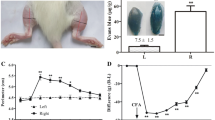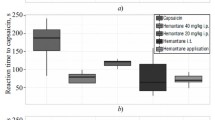Abstract
Axon reflex vasodilatation and neurogenic plasma extravasation are characteristic cutaneous vascular responses mediated by neuropeptides released from stimulated capsaicin-sensitive sensory nerve endings. Intracutaneous injections of local anaesthetics inhibit the axon-reflex flare elicited by chemical irritants in human skin. Results of earlier reports on the effects of local anaesthetics on neurogenic plasma extravasation are controversial. The aim of the present study, therefore, was to re-examine the effect of the local anaesthetic lidocaine on the neurogenic inflammatory response of rat skin. The effects of lidocaine on cutaneous inflammatory reactions were measured quantitatively by means of the Evans blue technique. Intracutaneous injection of lidocaine resulted in a dose-dependent inhibition of the neurogenic inflammation elicited by mustard oil and of the dye leakage response to compound 48/80 or histamine. It is suggested that the site of this inhibition is beyond the sensory nerve terminal, presumably at the level of the vascular endothelium.
Similar content being viewed by others
References
Jancsó G, Király E, Jancsó-Gábor A. Pharmacologically induced selective degeneration of chemosensitive primary sensory neurones. Nature 1977;270:741–3.
Jancsó G, Király E, Jancsó-Gábor A. Chemosensitive pain fibres and inflammation. Int J Tiss Reac 1980;2:57–66
Holzer P. Capsaicin: Cellular targets, mechanisms of action, and selectivity for thin sensory neurons. Pharmacol Rev 1991;43:143–201.
Jancsó N. Role of the nerve terminals in the mechanism of inflammatory reactions. Bull Millard Fillmore Hosp Buffalo, NY 1960;7:53–77.
Jancsó N. Desensitization with capsaicin and related acylamides as a tool for studying the function of pain receptors. In: Lim RKS, editor. Pharmacology of Pain. Oxford: Pergamon Press, 1968:33–55.
Lembeck F, Holzer P. Substance P as neurogenic mediator of antidromic vasodilation and neurogenic plasma extravasation. Naunyn-Schmiedelberg's Arch Pharmacol 1979;310:175–83.
Chahl LA. Antidromic vasodilatation and neurogenic inflammation. Pharm Ther 1988;37:275–300.
Jancsó-Gábor A, Szolcsányi J: The mechanism of neurogenic inflammation. In: Bertelli A, Houck JC, editors. Inflammation Biochemistry and Drug Interaction. Amsterdam: Excerpta Medica Foundation, 1969;210–7.
Lundberg JM, Saria A. Capsaicin-induced desensitization of airway mucosa to cigarette smoke, mechanical and chemical irritants. Nature 1983;302:251–3.
Erjefält I, Persson CGA. Pharmacologic control of plasma exudation into tracheobronchial airways. Am Rev Respir Dis 1991;143:1008–14.
Thon IL, Uvnas B. Degranulation and histamine release, two consecutive steps in the response of rat mast cells to compound 48/80. Acta Physiol Scand 1967;71:303–15.
Jancsó-Gábor A, Szolcsányl J, Jancsó N. A simple method for measuring the amount of azovan blue exuded into the skin in response to an inflammatory stimulus. J Pharm Pharmacol 1967;19:486–7.
Jancsó M. Histamine as a physiological activator of the reticulo-endothelial system. Nature 1947;160:227–8
Majno G, Palade GE, Schoefl GI. Studies on Inflammation: II. The site of action of histamine and serotonin along the vascular tree: A topographic study. J Biophys Biochem Cytol 1961;11:607–25.
Saria A, Lundberg JM, Skofitsch G, Lembeck F. Vascular protein leakage in various tissues induced by substance P, capsaicin, bradykinin, serotonin, histamine and by antigen challenge, Naunyn Schmiedeberg's Arch Pharmacol 1983;324: 212–8.
Gamse R, Saria A. Potentiation of tachykinin induced plasma protein extravasation by calcitonin gene-related peptide. Eur J Pharm 1985;114:61–6.
Louis SM, Jamieson A, Russel NJW, Dockray GJ. The role of substance P and calcitonin gene-related peptide in neurogenic plasma extravasation and vasodilatation in the rat. Neuroscience 1989;32:581–6.
Erjavec F, Lembeck F, Florjanc-Irman T, Skofitsch G, Donnerer J, Saria A, et al. Release of histamine by substance P. Naunyn-Schmiedeberg's Arch Pharmacol 1981;317:67–70.
Church MK, Lowman MA, Rees PH, Benyon RC. Mast cells, neuropeptides and inflammation. Agents Actions 1989;27: 8–16.
Szolcsányi J. Capsaicin and neurogenic inflammation: history and early findings. In: Chahl LA, Szolcsányi J, Lembeck F, editors. Antidromic vasodilatation and neurogenic inflammation. Budapest: Akadémiai Kiadó, 1984:7–25.
Maggi CA, Meli A. The sensory-efferent function of capsaicinsensitive sensory neurons. Gen Pharmacol 1988;19:1–43.
Johns RA. Local anesthetics inhibit endothelium-dependent vasodilatation. Anesthesiology 1989;70:805–11.
Author information
Authors and Affiliations
Additional information
accepted by K. Brune
Rights and permissions
About this article
Cite this article
Dux, M., Jancsó, G., Sann, H. et al. Inhibition of the neurogenic inflammatory response by lidocaine in rat skin. Inflamm Res 45, 10–13 (1996). https://doi.org/10.1007/BF02263498
Received:
Revised:
Accepted:
Issue Date:
DOI: https://doi.org/10.1007/BF02263498




